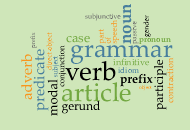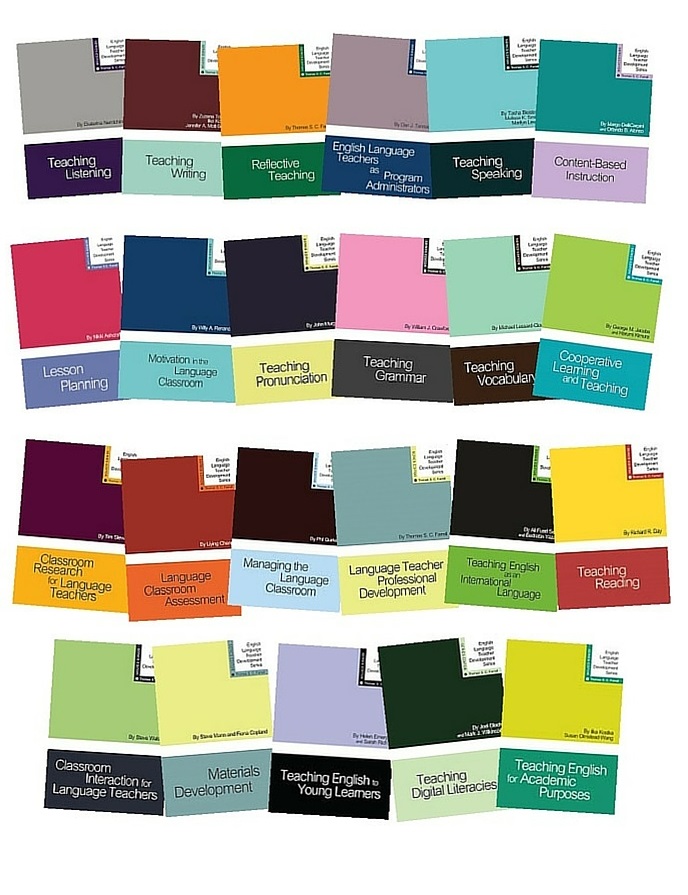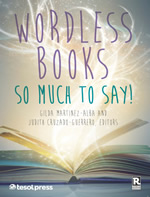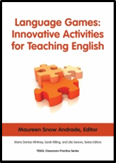Grammatically Speaking
by Michelle Jackson
 How to Teach Count vs. Noncount Nouns How to Teach Count vs. Noncount Nouns
The differences between count and noncount nouns are easier to distinguish in context. For that reason, the following activity has students find nouns in context, use cues to determine if they are count or noncount, and then create novel sentences.
Materials Required
- Each student should bring a 1-page article of interest to class. Ideally, each student will have read the article before arriving.
- Paper and writing utensils for all students.
Timing: 25 minutes
Step 1
The instructor explains the differences between count nouns and noncount nouns. For example, count nouns:
- take an “–s” when they are pluralized (e.g., elephants, flowers, books, costumes); and
- can be preceded by articles such as “a,” “an,” and “the” (e.g., the elephant in the room). minute
In addition to the characteristics noted above, these two categories of nouns differ in terms of which adjectives can precede them. (5 minutes)
|
Type of Noun |
Adjective That Expresses Quantity |
Example Noun |
| count nouns |
many, some, few |
leader, camera, shoe |
| noncount nouns |
much, little, any |
oxygen, heat, furniture, advice |
Step 2
Students read through their article, circling all the nouns they find. (5 minutes)
Students divide a sheet of paper into two columns: count nouns and noncount nouns. Students look at the nouns they circled in their article and determine if they are count nouns or noncount nouns given their context. Students sort the nouns into the appropriate columns. (5 minutes)
Step 3
Students select three count nouns and three noncount nouns from their list and create novel sentences with them, being sure to follow the aforementioned rules above. (10 minutes)
Optional Extension
You can allow students to choose their own article, which increases student motivation. Or, you could kill two birds with one stone and have students select a reading based on the theme of the current lesson.
To lengthen the activity, you might also cover adjectives such as “enough” and “plenty” that can be used with both count and noncount nouns.
Happy teaching,
Michelle
Dr. Michelle Jackson is the associate director of teaching at New Mexico State University’s Teaching Academy. She designs, develops, and delivers workshops on a variety of teaching and learning topics. Prior to NMSU, she was the manager of the English Language Institute at UT El Paso. She has taught English as a second language at UT El Paso and Harvard University as well as Spanish at UT Austin.
TC Monthly Giveaway Congratulations to Marcia Luptak, of Elgin, Illinois, USA for being the winner of the November 2015 TESOL Connections Monthly Giveaway. Marcia has won a free copy of Assessing English Learners in U.S. Schools.
This month, TESOL is giving away
A free registration to the
TESOL Annual Convention
& English Language Expo
in Baltimore, Maryland, USA
5–8 April 2016!

Join TESOL in celebrating its 50th anniversary!
The TESOL annual convention will bring professionals and scholars from around the world to Baltimore. With more than 1,000 sessions, you’ll be able to explore not only teaching techniques that work, but the latest research in the field, the newest software and publications on the market, and just about anything else that supports English language educators.
View all convention details on the TESOL Convention Website
Click here to enter
Drawing closes 27 December 2015, 11:59 pm EST
TESOL Blogs Interested in writing a blog for TESOL?
Read the submission guidelines and send us your post!
Check out the latest TESOL Blogs:
|
Teaching Elementary-Age ELs the Hidden Curriculum, by Judie Haynes
 What is the hidden curriculum? This term encompasses various characteristics of schooling that “everybody knows.” It usually consists of a wide variety of social skills, such as interactions with peers and teachers, and includes the fundamental values and beliefs of a school community. This hidden curriculum needs to be learned by ELs in order for them to succeed socially and academically in school. What is the hidden curriculum? This term encompasses various characteristics of schooling that “everybody knows.” It usually consists of a wide variety of social skills, such as interactions with peers and teachers, and includes the fundamental values and beliefs of a school community. This hidden curriculum needs to be learned by ELs in order for them to succeed socially and academically in school.
How do your ELs discover this underlying curriculum? Do you teach it directly or hope that they will acquire socially appropriate behavior and language simply by being with native English speakers? Read More. |
|
Can We Really “Teach Peace”?, by Kristen Lindahl
 In light of recent violence in the world, I have been pondering the role of educators in this shifting paradigm. As members of an international organization, TESOL professionals can be found in every part of the globe, working with all types of people across differences in age, culture, ethnicity, gender, language, race, and religion. As a group, we are continually touched by events outside of our classrooms, and this requires us to be aware of economic, political, and social affairs that impact us as well as our students. Read More. In light of recent violence in the world, I have been pondering the role of educators in this shifting paradigm. As members of an international organization, TESOL professionals can be found in every part of the globe, working with all types of people across differences in age, culture, ethnicity, gender, language, race, and religion. As a group, we are continually touched by events outside of our classrooms, and this requires us to be aware of economic, political, and social affairs that impact us as well as our students. Read More.
|
|
5 Ways to Make the Most of Written Feedback, by Nathan Hall
 Do you remember getting papers back from your English or composition teachers that were covered in red ink? Did you take the time to decode each individual marking, consider every error, and diligently redraft your paper until it was flawless? Really? You did? Because I remember scanning for my grade, then fixing the mistakes marked by symbols as disinterestedly as if they were math problems—but only when revisions were required. The most frustrating part was that I made mistakes when I knew the correct rule, but somehow I just tapped the wrong key or picked the wrong word. Read More. Do you remember getting papers back from your English or composition teachers that were covered in red ink? Did you take the time to decode each individual marking, consider every error, and diligently redraft your paper until it was flawless? Really? You did? Because I remember scanning for my grade, then fixing the mistakes marked by symbols as disinterestedly as if they were math problems—but only when revisions were required. The most frustrating part was that I made mistakes when I knew the correct rule, but somehow I just tapped the wrong key or picked the wrong word. Read More.
|
|
3 WebQuests to Engage Your ELLs With Content!, by Sherry Blok
 Tired of fighting against the current? Students love their phones and want to engage in online activity, so why not put those cellphones to good use? WebQuests have proven to be highly effective to: Tired of fighting against the current? Students love their phones and want to engage in online activity, so why not put those cellphones to good use? WebQuests have proven to be highly effective to:
- Engage students with content
- Improve reading comprehension
- Improve reading skills, such as skimming and scanning
- Develop information-literacy skills
- Develop computer-literacy skills
- Develop problem-solving skills
- Develop ability to work in teams
Read More. |
TESOL Bookstore

Featured Resources from TESOL Press
English Language Teacher Development Series: PDF Bundle
Series Editor: Thomas S. C. Farrell

What's the latest research, and how do I use it in my classroom? Keeping updated is an ongoing task for a profession that continuously reinvents itself. These short, accessible reference tools are of immediate relevance to practicing teachers in the ESL, EFL, EIL, and ESOL classrooms. Ideal for ESOL master's programs and skills courses. Get all 23 titles in PDF format with this series bundle.
 Wordless Books: So Much to Say! Wordless Books: So Much to Say!
Gilda Martinez-Alba and Judith Cruzado-Guerrero, Editors
Enable your students to be successful regardless of their literacy levels. Wordless books help to develop oral language, listening, vocabulary, and so much more! With wordless books, K–12 and adult students can be authors and write stories that they interpret from the pictures. Includes additional online resources and editable rubrics.
 Language Games: Innovative Activities for Teaching English Language Games: Innovative Activities for Teaching English
Maureen Snow Andrade
Part of the Classroom Practice Series, this volume contains a variety of games used in language classrooms around the globe, reflecting different contexts and cultures. Chapters demonstrate how both theory and practice inform teaching approaches, and games focus on reading, writing, listening, speaking, grammar, critical thinking and more.
|
 |
|
|
 |
| Assistant Director, English Language Training Institute, University of North Carolina at Charlotte, Charlotte, North Carolina, USA
Middle School ESL Teacher, Opportunity Charter School, New York, New York, USA
ESL Instructor, Vinnell Arabia - Saudi Arabian National Guard Modernization Program, Riyadh, Saudi Arabia
Want to post your open positions to Job Link? Click here.
To browse all of TESOL's job postings, check out the TESOL Career Center. |
 |
|
 |
| ADVERTISEMENT |
 |
 |
|